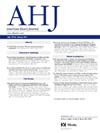美国儿童和青少年NT-proBNP浓度相关因素:1999-2004年全国健康和营养检查调查
IF 3.7
2区 医学
Q1 CARDIAC & CARDIOVASCULAR SYSTEMS
引用次数: 0
摘要
n -末端前b型利钠肽(NT-proBNP)是一种生物惰性裂解产物,是一种响应心肌壁应激形成的肽,可用于筛查成人亚临床心血管疾病。然而,年轻人NT-proBNP与人口统计学、生活方式和心脏代谢因素之间的关系尚不清楚。方法与结果:我们对1999年至2004年具有全国代表性的全国健康与营养调查中20岁的年轻人进行了横断面分析,并测量了储存的血清标本中的NT-proBNP。我们计算了NT-proBNP的年龄和性别特异性分布,并评估了NT-proBNP与心脏代谢危险因素之间的关系。我们发现NT-proBNP与BMI和大多数心脏代谢危险因素在美国儿童和青少年中呈负相关。结论:年轻人NT-proBNP在年龄、性别、种族或民族方面的差异与成年人相似。这些结果表明,与成人一样,儿童和青少年的NT-proBNP水平应该基于这些人口统计学和临床因素来解释。本文章由计算机程序翻译,如有差异,请以英文原文为准。
Factors associated with NT-proBNP concentration in US children and adolescents: National Health and Nutrition Examination Survey 1999-2004
Background
N-terminal pro-B-type natriuretic peptide (NT-proBNP) is a biologically inert cleavage product of a peptide formed in response to myocardial wall stress and can be used to screen for subclinical cardiovascular disease in adults. However, associations between NT-proBNP and demographic, lifestyle, and cardiometabolic factors in youth are poorly characterized. Methods and Results: We conducted a cross-sectional analysis of youth ages <20 years old in the nationally representative National Health and Nutrition Examination Survey 1999 to 2004 and measured NT-proBNP in stored serum specimens. We calculated age-and-sex-specific distributions of NT-proBNP and evaluated the associations between NT-proBNP and cardiometabolic risk factors. We found that NT-proBNP was inversely associated with BMI and most cardiometabolic risk factors in the general US population of children and adolescents.
Conclusions
The differences in NT-proBNP by age, sex, and race or ethnicity in younger persons mirror those seen in adults. These results suggest that as in adults, levels of NT-proBNP should be interpreted in children and adolescents based on these demographic and clinical factors.
求助全文
通过发布文献求助,成功后即可免费获取论文全文。
去求助
来源期刊

American heart journal
医学-心血管系统
CiteScore
8.20
自引率
2.10%
发文量
214
审稿时长
38 days
期刊介绍:
The American Heart Journal will consider for publication suitable articles on topics pertaining to the broad discipline of cardiovascular disease. Our goal is to provide the reader primary investigation, scholarly review, and opinion concerning the practice of cardiovascular medicine. We especially encourage submission of 3 types of reports that are not frequently seen in cardiovascular journals: negative clinical studies, reports on study designs, and studies involving the organization of medical care. The Journal does not accept individual case reports or original articles involving bench laboratory or animal research.
 求助内容:
求助内容: 应助结果提醒方式:
应助结果提醒方式:


